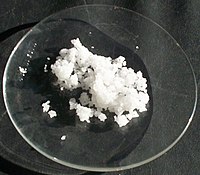
Photo from wikipedia
The conversion of ethanol over a commercial ZnAl2O4 has been investigated. The catalyst has been fully characterized by XRD, IR, UV–Vis-NIR, ICP-OES, EDX-FE-SEM, BET and porosimetry. The catalyst is active… Click to show full abstract
The conversion of ethanol over a commercial ZnAl2O4 has been investigated. The catalyst has been fully characterized by XRD, IR, UV–Vis-NIR, ICP-OES, EDX-FE-SEM, BET and porosimetry. The catalyst is active in converting ethanol. At low conversion, diethyl ether is the main product while at higher conversions acetaldehyde is the main product (max yield ~ 50%). Ethylene and ethyl acetate are coproduced. Acetone and propylene become relevant products at complete conversion. The mechanism of formation of the products is discussed based on infrared surface chemical data, thermodynamic and kinetic data. Two independent catalytic sites exist, one for dehydration, the other for dehydrogenation, similar to those of Zinc oxide, giving rise to two parallel reaction sequencies. Criteria for developing selective catalysts towards dehydrogenation products are briefly discussed.
Journal Title: Reaction Kinetics, Mechanisms and Catalysis
Year Published: 2018
Link to full text (if available)
Share on Social Media: Sign Up to like & get
recommendations!